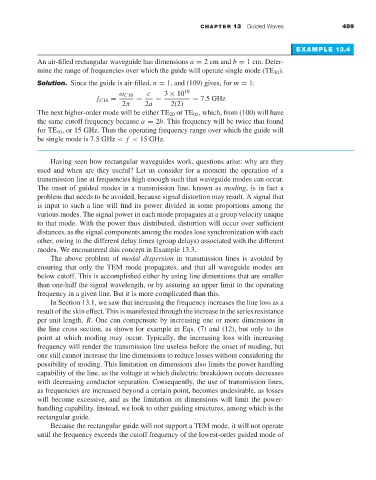Page 507 - Engineering Electromagnetics, 8th Edition
P. 507
CHAPTER 13 Guided Waves 489
EXAMPLE 13.4
An air-filled rectangular waveguide has dimensions a = 2cm and b = 1 cm. Deter-
mine the range of frequencies over which the guide will operate single mode (TE 10 ).
Solution. Since the guide is air-filled, n = 1, and (109) gives, for m = 1:
ω C10 c 3 × 10 10
f C10 = = = = 7.5 GHz
2π 2a 2(2)
The next higher-order mode will be either TE 20 or TE 01 , which, from (100) will have
the same cutoff frequency because a = 2b. This frequency will be twice that found
for TE 10 ,or15 GHz. Thus the operating frequency range over which the guide will
be single mode is 7.5 GHz < f < 15 GHz.
Having seen how rectangular waveguides work, questions arise: why are they
used and when are they useful? Let us consider for a moment the operation of a
transmission line at frequencies high enough such that waveguide modes can occur.
The onset of guided modes in a transmission line, known as moding,isinfacta
problem that needs to be avoided, because signal distortion may result. A signal that
is input to such a line will find its power divided in some proportions among the
various modes. The signal power in each mode propagates at a group velocity unique
to that mode. With the power thus distributed, distortion will occur over sufficient
distances, as the signal components among the modes lose synchronization with each
other, owing to the different delay times (group delays) associated with the different
modes. We encountered this concept in Example 13.3.
The above problem of modal dispersion in transmission lines is avoided by
ensuring that only the TEM mode propagates, and that all waveguide modes are
below cutoff. This is accomplished either by using line dimensions that are smaller
than one-half the signal wavelength, or by assuring an upper limit to the operating
frequency in a given line. But it is more complicated than this.
In Section 13.1, we saw that increasing the frequency increases the line loss as a
result of the skin effect. This is manifested through the increase in the series resistance
per unit length, R. One can compensate by increasing one or more dimensions in
the line cross section, as shown for example in Eqs. (7) and (12), but only to the
point at which moding may occur. Typically, the increasing loss with increasing
frequency will render the transmission line useless before the onset of moding, but
one still cannot increase the line dimensions to reduce losses without considering the
possibility of moding. This limitation on dimensions also limits the power handling
capability of the line, as the voltage at which dielectric breakdown occurs decreases
with decreasing conductor separation. Consequently, the use of transmission lines,
as frequencies are increased beyond a certain point, becomes undesirable, as losses
will become excessive, and as the limitation on dimensions will limit the power-
handling capability. Instead, we look to other guiding structures, among which is the
rectangular guide.
Because the rectangular guide will not support a TEM mode, it will not operate
until the frequency exceeds the cutoff frequency of the lowest-order guided mode of

